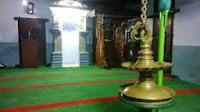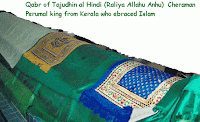The Song was Composed on George's Veranda
In the introduction to the patriotic song,Viduthalai,of Subramanya Bharati, S Sowmya says, her Guru,Dr S Ramanathan had told her that the song was composed in Pondicherry,inspired by the French national anthem.It is not so.While it is true that Bharatiyar had escaped to the French ruled Pondicherry in 1908 and remained there till 1918,the song was composed in the Madurai home of Barrister George Joseph,who was practicing there.While the life of Bharatiyar is well known,only few Malayalis remember the Christian nationalist,George Joseph,who was in jail with Jawahar Lal Nehru,who had led the Vaikam Satyagraha and who was,Editor of,Gandhi's Young India.
That wonderful moment in the life of Bharatiyar,is recorded in the biography,George Joseph:The Life and Times of a Kerala Christian Nationalist,by George Gheverghese Joseph,grandson of George,who also wrote the famous, The Crest of the Peacock,on the non European roots of Mathematics.SONG:VIDUTHALAI/SUBRAMANYA BHARATI/S SOWMYA
I quote from the book:
Living during such an eventful period of Indian history,Bharati threw himself into the freedom struggle,using his poetic gifts to arouse the people.One of his songs,Viduthalai,Viduthalai(Let Go,Let Go),became the clarion call for freedom from foreign rule.The back ground to the composition of this song is interesting.The few years before his death in 1921 were years of great hardship and poverty ,induced partly by the restrictions on his movements by the government and partly by his opium addiction.It was during this period that Bharati practically lived on the veranda of the Joseph residence in Madurai.Susannah had a soft corner for this otherworldly charming poet and looked after him as if he were a member of the family.She recalls the time when Bharati rose as if from a trance,shouting in Tamil to all present,"Kottada,Kai Kottada!"("Clap! Clap your hands!") and then went on to sing as he composed,Viduthalai.
It is from this book I came to know that Bharatiyar was an addict to opium.I also felt that the family could have promoted him from the veranda,though it is the safe place for an addict!(Viduthalai means Freedom,not Let Go).
 |
| Bharati with wife Chellamma |
Subramanya Bharati(1882-1921),within a short span of 39 years,left an indelible mark as a poet on Tamil nationalism,and he was first an Indian,then a Tamil.He was fortunate to have been born in Ettayapuram,and to be recognized as a poet at the early age of 11,and to become the court poet of the Raja of Ettayapuram,because it was in that court,the Dikshitar brothers sang and played Violin.Subramanyan,son of Chinna Swamy Subramanya Iyer and Lakshmi Ammal,was accorded the title,Bharati,there itself.His mother died when he was just 5,and father,two years later.He married a seven year old Chellamma in 1898 and was in Kasi,till 1902,before becoming a teacher and Assistant Editor of Swadesa Mitran,in 1904.Meeting Sister Nivedita,disciple of Swami Vivekananda in 1905 was a turning point,and he considered her,his Guru.He attended the Congress sessions of Kolkata(1906) which demanded Swaraj for the first time,and Surat(1907),which saw the fight between the militant faction of Bal Gangadhar Tilak and Aurobindo with the moderates.Bharati was with the militants,which comprised Kappalottiya Thamizhan, V O Chidambaram Pillai and Kanchi Venkatachariyar.He gave evidence in the case framed by the British against Pillai and with the prospect of being arrested,escaped to Pondicherry.He met with Aurobindo and V V S Iyer when they arrived at Pondicherry in 1910.
When Bharati reached Pondicherry,George Joseph was doing Law at Middle Temple,London and he returned as Barrister to India in 1909,and married Susanna,forgetting his love in Britain,Mary Caldwell.His mother had threatened to commit suicide,if he married her.
George(1887-1938)was the eldest of 9 children of Oorayil C I Joseph of Chengannur,an Engineer and Saramma in the former princely state of Travancore in Kerala.Never a brilliant student,he studied FA in Madras Christian College,and knowing his hate for distant places,his father told him,if he passes,he can continue in the same college,but if he fails,he would be sent to Britain.He failed and celebrated it by jumping from a hay stack.He was the first Syrian Christian to go to Britain for higher studies;he went in 1904 along with K P Gopala Menon,brother of K P S Menon.When both were invited by Prof Asquith,Principal of CMS College,Kottayam,both went with younger brothers,Pothan Joseph and KPS Menon,giving the Asquith family a surprise,and the younger brothers sipped tea,from the saucer,for the embarrassment of the family.Though K PS Menon poured the tea back into the cup,Pothan Joseph continued sipping from the saucer,and took it to great heights,by naming his column,Over a Cup of Tea,when he became a celebrated Editor. George did MA Philosophy at University of Edinburgh,where Prakash Karat studied,years later.He did Law at Middle Temple,London.He set up law practice first at Madras,edited South India Mail, and then,at the advise of criminal lawyer Gopala Menon, shifted to Madurai.He modeled himself on famous lawyer,the founding member of the Congress,Eardley Norton,who had appeared for the accused including Aurobindo,in the Alipore conspiracy case, and became a reputed criminal lawyer.He vehemently opposed the Criminal Tribes Act(CTA)of the British which branded certain communities like Piramalai Kallars and Maravars,as criminals. He joined the Home Rule movement and was selected by Annie Besant in 1918,as part of a three member delegation to speak in Britain on home rule.Syed Hussain,whom Vijya Lakshmi Pandit loved(Gandhi was against that affair;she later used to offer floral tribute to him at his qabr in Cairo) and B V Narasimhan were the other members and the three were arrested at Gibraltar and deported to India.When P Varadarajulu Naidu was arrested for making a speech at Victoria Edward Library Hall,Madurai,George assisted C Rajagopalachari who appeared in the case and Naidu was exonerated.He organized the textile mill workers in and around Madurai.
 |
| George Joseph |
Rajaji introduced George to Gandhi on March 22, 1919 at Madras,and when Gandhi visited Madurai on March 26,stayed at the house of George.Gandhi spoke at a widely attended public meeting against the Rowlett Act on 29th. At Gandhi's instigation,George threw off his roaring practice and went to North India.He moved closely with the giants of freedom struggle for four years.Motilal Nehru selected him to edit The Independent,at Allahabad and was soon arrested on sedition charges on December 6,1921,and one of his prison-mates was Jawaharlal Nehru.On his release two years later,he was chosen by Gandhi to edit his weekly,Young India,succeeding, Rajaji.He took charge on September 27,1923,and worked only for six months.He returned to Kerala next year,with growing disenchantment with the factionalism within congress coupled with the illness of his wife,and he found himself in the midst of Vaikam Satyagraha.The issue was that the dalits were not permitted on the Siva temple roads although,Christians and Muslims were allowed.George was arrested,and while he was undergoing six months imprisonment,the Nairs in the Congress complained to Gandhi against a Christian leading a movement,around the temple. Gandhi lent his ears to those casteist forces,and wrote to George:I think that you should let the Hindus do the work.It is they who have to purify themselves.You can help by your sympathy and by your pen,but not by organizing the movement and certainly not by offering satyagraha.
The casteist in Gandhi was out,and,George,disillusioned with Gandhi,joined the Justice Party,but returned to the Congress in 1935.
 |
| Bharatiyar |
He corresponded with B R Ambedkar on Vaikam Satyagraha and mass conversion and wrote in The Hindu,an article,Gandhiji's New Formula,criticizing his actions on Khadi,Salt Act and prohibition.
It was after his return to Madurai from Travancore,he met Bharati.Though George had distanced himself from Gandhi,he maintained his friendship with Kamaraj; they organized a mass rally against Simon Commission's visit to Madurai,in 1929,and Varadarajulu Naidu and George appeared for Kamaraj,when he was implicated in the Virudhunagar conspiracy case(1933).George,at this time,received a post card from Gandhi,in which he asked:Oh George Joseph,why you have forsaken me?Of Gandhi's vision of a future India,George had remarked:Some call it Gandhiraj,others,Swaraj.In reality,it is Hindu Ramaraj.George was very sceptical of Gandhi's claim that his 'inner voice' acted as his conscience.
 |
| Statue of George |
His disappointments in his political life were accentuated by his failure to win two elections,as a result of caste and religious parochialism and he began dabbling in Roman Catholicism and its medieval cultural baggage.After his return to Congress,he was elected to the Central Legislative Assembly from the Madurai/Ramnad/Tirunelveli constituency,unopposed,in 1937.He attended just one session,died in Madurai on 5 March,1938.Gandhi wrote to Susannah:I have before me your most pathetic and humane letter.I have seen your longer and fuller letter to Mahadev Desai.You must not grieve.That will show lack of faith in God.He gives and takes away.And surely it is with Joseph.You will come to me whenever you can and want to.You shall remain a dear daughter and more so;if possible,now that Joseph is no more in our midst in the flesh.Love to you and children-Bapu.
 |
| Gandhi's letter to Susanna |
Incidentally,it was on his visit to Madurai,in 1925,and in the house of George,Gandhi took the historic decision to switch over to his trade mark loin cloth,after he found,people coming for his darshan,were bare footed and bare bodied,except for a dhoti, around their waist.The decision came after the public meeting at Thiagaraja College.Recently when I visited Madurai,I was shocked at the sight of the blood stained cloth of Gandhi,which he wore at the time of his assassination,at the Gandhi Memorial.I was not prepared to see the cloth,because I had thought,it would be in Rajghat,Delhi.
In 1966,a statue of George Joseph was erected at the Yanaikkal Junction in Madurai.Every year,on his death anniversary,the Piramalai Kallars tribe offer flower tribute to him-they still name their children,Rosapoo or Rosappa Durai, in honour of Joseph.Maybe it is a mispronunciation of Joseph,or it is remembrance of the rose flower on his lapel.
Coming back to Sowmya,she was partly right,when she said Bharati was inspired by the French national Anthem.It is very militant,and it says:
The Day of Glory has Arrived!
..................................
To Arms Citizens!
Form Your Batallions
Let us March!Let us March!
So that the impure Blood
Waters our Fields!
Bharati's Viduthalai,Viduthalai,rhymes like the French,Marchons,Marchons(Let us March).
SONG:THE FRENCH NATIONAL ANTHEM/LA MARSEILLAISE
This post is dedicated to Sowmya,who grew up at Ambalamedu close to my place,Tripunithura,near Cochin,Kerala.Her father,Dr Srinivasan was a Chemical Engineer at FACT,if I remember right,what she said during the MDR commemorative concert at Tripunithura.
Reference:
1.George Joseph:The Life and Times of a Kerala Christian Nationalist/George Gheverghese Joseph
2.M K Gandhi/Collected Works of Mahatma Gandhi/XXIII/page 391-Gandhi's letter on Vaikam Satyagraha
3.Unions in Conflict:A Comparative Study of Four South Indian Textile Centres 1918-1993/Eamon Murphy
4.Barrister George Joseph:A Memoir/Maya Thomas
5.George Joseph and the National Struggle for Freedom/R Renjini
Bharati Signature
See my Post,PARASURAMA,DALITS AND THE ART OF AXING
































